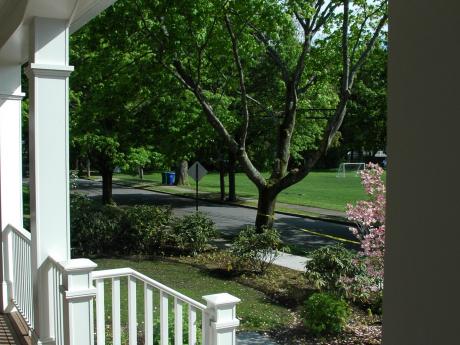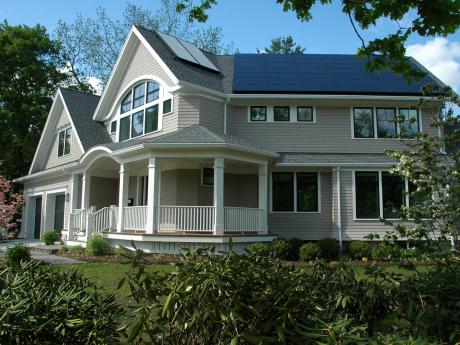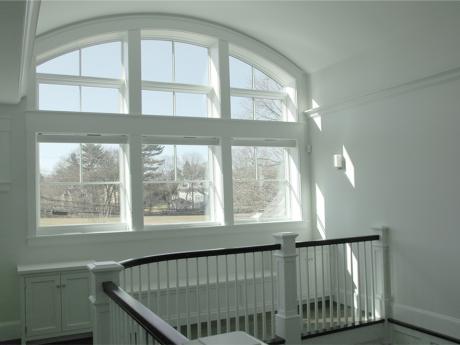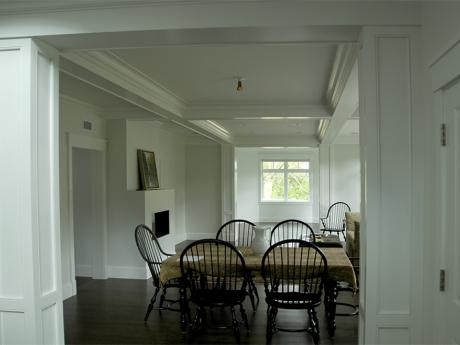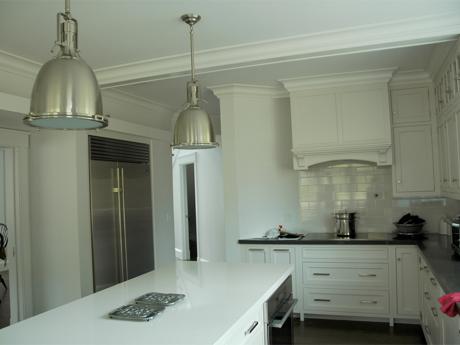Miller Residence
Project Photo Gallery
Project Team
This new residence in the Boston suburb of Newton, MA, achieves net-zero within a neighborhood context. In the owner David Miller’s words, “climate change is the issue of the century,” and this house is built to address that fact. He and his family also take small steps each day to reduce their energy consumption, like using the clothes dryer as little as possible and keeping the thermostats low, Karen Miller notes, “The savings we are getting is because of how our home is built.”
The Millers chose the site for their home because of the location. The close proximity to the T allows them to use public transportation regularly, an adjacent park provides recreation out the front door, and the small center within walking distance has restaurants and shops. A small existing home on the property was deconstructed and building materials salvaged for reuse to the greatest extent possible.
The house is designed with the main entry facing the main street, preserving the formal and traditional street presence typical of the neighborhood. However, a large wing of the home is built at a 45 degree angle to the street, maximizing the south facing roof. This roof is covered in photovoltaic panels. Solar domestic hot water panels are located on the south-east facing slope of the front gable. Large south facing windows optimize passive solar gain to help heat the house and provide a connection to the outdoors for the occupants.
The house is super-insulated, with an R-20 basement, R-40 walls, R-5 windows and an R-60 roof. Heating and cooling, if needed, is provided by an air-source heat pump, which is powered by the electric provided by the home’s PV panels.
The Miller’s new home uses 88% less energy than the couple’s previous home, built in 2005. Additionally, the production of energy on-site will save the couple approximately $6,000 annually in energy costs. Combining energy rebates with the reduced energy costs, the renewable energy system is on track to pay for itself after only four years.
The Miller’s recognize their net-zero home is large, compared to the US average home size in 2010 of 2,169 SF. However, for the neighborhood, their home is on the small end. A quick search of public property records for homes built in the neighborhood in the last 10 years, gives an average size of 4,553 SF of above ground living area, putting the Miller’s home in the 29th percentile for size. An important factor for the Millers when designing their home was to create a space where they could raise their two children, but also where they could work. Both of the Millers work out of their new home, decreasing their overall energy footprint, but increasing both the size requirement for the house and its overall energy demand.
Quick Facts
General
| Location | Newton, Massachusetts |
|---|---|
| Building Type | Single-Family Residence |
| Project Type | |
| Basis of Performance Claim | |
| Conditioned Floor Area | 5,329 sq ft |
Energy Summary
| Energy Data Type | |
|---|---|
| Renewable Energy System Type(s) | |
| Ratings | |
| Net electricity usage (purchased) | 1,817 kWh/year |
Envelope and Mechanicals
| Subslab assembly |
4” XPS rigid insulation |
|---|---|
| Foundation wall assembly |
2” XPS, 6” loose fill cellulose |
| Above grade wall assembly |
2” poly-isocyanurate, dense pack cellulose in 2x8 wall cavity |

